Use a Multifunction Power Supply to Quickly Implement Intelligent Fire Safety and Security Systems
Contributed By DigiKey's North American Editors
2023-09-25
Designers of state-of-the-art buildings, especially high-rise structures, must provide reliable fire and security alarm systems, fire control, emergency responder communications repeaters, emergency lighting, and access control systems. These increasingly intelligent systems rely upon a stable power supply that must continue to operate and maintain status communication even when line power is lost or compromised. They must also be cost-effective and scalable across a variety of applications to meet changing design requirements.
To help meet these challenges, designers can turn to off-the-shelf, DIN rail mounted digital security power supplies that integrate a standard AC-DC power supply, a battery charger, a DC uninterruptible power supply (DC UPS), and Modbus or CAN bus communications. These elements work interactively to ensure correct system operation even under conditions of severe disruption. Supplies with DC output of 12, 24, 36, or 48 volts are available to accommodate a wide variety of security system configurations. Power supply status is reported locally via LED indicators and remotely via relay contact closures.
This article will discuss the power security challenges designers face in modern buildings. It will then look at exemplary intelligent security power systems from MEAN WELL and show how they can be applied to multiple emergency backup systems.
Security system power supplies
Security systems for buildings include fire protection, access control, alarms, emergency lighting, and emergency communications. These systems are intended to ensure the safety of building occupants and emergency responders in the event of a catastrophic incident. Building and fire safety codes require that these critical systems have two or more power sources, one of which should be a rechargeable battery. Additionally, security system power should be uninterruptable. Therefore, the security system's power needs include a power supply, a DC UPS, and a battery charger. If applied in a remote location, the system also requires status reporting to alert users of any anomalies.
MEAN WELL offers a unique solution to these requirements in the form of an all-in-one intelligent security power supply, the DRS-240/480 family. The power supplies in this family, such as the DRS-480-24 24 volt, 480 watt output version, are integrated multifunction units that include an AC-DC power supply, battery charger, and DC UPS in a single DIN rail-mounted module to simplify system design. Together with a backup battery pack and an alarm control module, the supplies form the foundation of a basic security fire alarm control system (Figure 1).
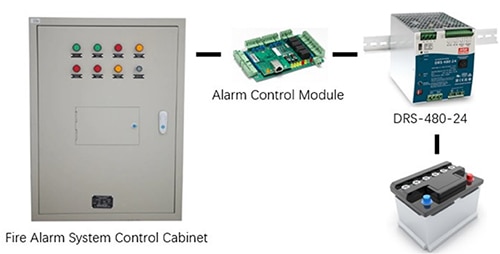 Figure 1: Shown is a basic security fire alarm control system comprising a DRS-480-24 power supply, a backup battery pack, and an alarm control module, all contained within the fire alarm system control cabinet. (Image source: MEAN WELL)
Figure 1: Shown is a basic security fire alarm control system comprising a DRS-480-24 power supply, a backup battery pack, and an alarm control module, all contained within the fire alarm system control cabinet. (Image source: MEAN WELL)
The DRS-480-24 power supply operates from 90 to 305 volts AC or 127 to 431 volts DC. The module measures 110 millimeters (mm) (4.3 inches (in.)) wide, 125.2 mm (4.9 in.) high, and 150.7 mm (5.9 in.) deep. An efficiency of up to 93.5% allows it to operate at ambient temperatures of -30°C to +70°C using free-air convection cooling. It is protected against current overload, overvoltage, and reverse battery protection. It also has a low battery disconnect function.
The DRS-240/480 family has output power levels of 240 or 480 watts and four different output voltage levels of 12, 24, 36, or 48 volts. The power supply dimensions vary with the power ratings. The DRS-240 is somewhat smaller than the DRS-480 already mentioned. Its dimensions are 85.5 mm (3.4 in.) wide, 125.2 mm (4.9 in.) high and 129.2 mm (5.1 in.) deep.
The supplies can be installed on DIN rail TS-35/7.5 or 15. DIN mounting permits multiple modules to be placed adjacent to each other to save space. Being DIN mounted, wiring for connections such as relay-based status and serial communications via Modbus or CAN bus is readily accessible because it is all done from the front panel (Figure 2).
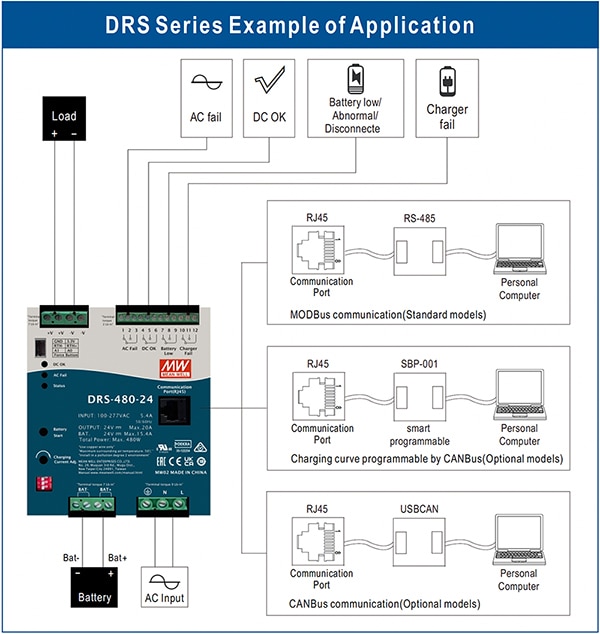 Figure 2: Connections to the power supply, such as for relay-based status and Modbus or CAN bus communication, are easily accessible via the front panel’s wiring contacts. (Image source: MEAN WELL)
Figure 2: Connections to the power supply, such as for relay-based status and Modbus or CAN bus communication, are easily accessible via the front panel’s wiring contacts. (Image source: MEAN WELL)
In addition to the input and output power connections, the power supplies also have Form C single pole, double throw (SPDT) relay contacts to indicate AC fail, DC OK, battery low/abnormal/disconnected, or charger failed status. The RJ-45 communications port provides a serial data interface for monitoring and control via Modbus or CAN bus. These buses are used to convey status updates for output voltage, current, or temperature, and to control the unit, including device on/off, set output voltage/current levels. They are also used to set the battery charging parameters, including constant current, constant voltage, float voltage, taper current, battery temperature compensation, and charge time.
DIP switches in the upper left quadrant also allow manual setting of the charger characteristics to match multiple types of lithium or lead-acid batteries using either two-stage (constant current followed by constant voltage) or three-stage (constant current followed by constant voltage followed by float) charging (Figure 3).
 Figure 3: Battery charging profiles are selectable by DIP switches to be either two or three stage. (Image source: MEAN WELL)
Figure 3: Battery charging profiles are selectable by DIP switches to be either two or three stage. (Image source: MEAN WELL)
The charging curves can also be programmed using the optional SBP-001 intelligent battery charging programmer.
The power supply uses a classic pulse width modulated (PWM) switch mode power design with additional elements added to intelligently control its additional roles as a power monitor, battery charger, and a UPS (Figure 4). Power factor correction (PFC) and electromagnetic interference (EMI) filtering precede the core power supply.
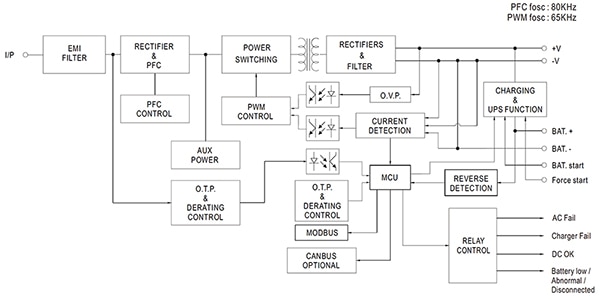 Figure 4: The block diagram shows a DRS-240/480 family intelligent security multifunction power module, including battery charging, UPS functions, PFC, and power monitoring. (Image source: MEAN WELL)
Figure 4: The block diagram shows a DRS-240/480 family intelligent security multifunction power module, including battery charging, UPS functions, PFC, and power monitoring. (Image source: MEAN WELL)
PWM control of the switching duty cycle is based on voltage and current feedback. Note the provision in the design for overvoltage protection (OVP), overload (OVL) current, and over-temperature protection (OTP). The microcontroller unit (MCU) provides multimode control for battery charging, battery monitoring, and communications.
Applications for DRS-240/480 intelligent security power supplies
Many fire, security, and safety systems are required by building and fire codes to operate using backup power in the event of a utility power interruption. One such system is a bi-directional amplifier (BDA) that provides active communications support for emergency responders operating in buildings where wireless communication is proving difficult (Figure 5). It acts as a repeater to amplify and retransmit signals from emergency responders’ radios.
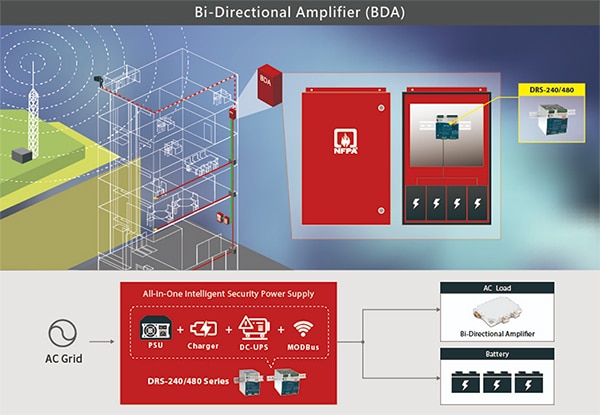 Figure 5: BDAs act as repeaters to amplify and retransmit signals from emergency responders’ radios within a building. (Image source: MEAN WELL)
Figure 5: BDAs act as repeaters to amplify and retransmit signals from emergency responders’ radios within a building. (Image source: MEAN WELL)
BDAs and associated antennas are especially useful in larger high-rise structures where they are distributed over many floors. These systems also link the BDA to responder signals from outside the building and relay them internally. BDAs require power even when normal mains power fails. The DRS-240/480 power supplies, with their associated batteries, guarantee power by reverting to battery backed DC UPS mode when mains power is lost. If the AC mains drops below the range of 79 to 89 volts AC for a 120-volt line, or below the range of 132 to 187 volts AC for a 220 volt line, the DC UPS function will activate, and power will switch to battery backup.
Emergency power systems also supply backup power to systems that guide and aid occupants and responders when evacuating a structure. Example systems include illuminated exit signs, evacuation route floor lights, and emergency lighting (Figure 6).
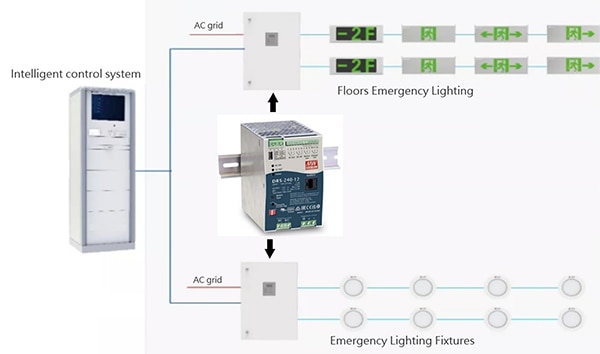 Figure 6: Shown is an intelligent lighting control system that is using a DRS-240 power supply as the backup power source to supply light and emergency signs during an emergency event. (Image source: MEAN WELL)
Figure 6: Shown is an intelligent lighting control system that is using a DRS-240 power supply as the backup power source to supply light and emergency signs during an emergency event. (Image source: MEAN WELL)
In this lighting control system, the DRS-240-12 provides the backup power source to maintain critical emergency lights and signs in the event of mains failure. This supply is rated at 12 volts, 240 watts and can supply up to 20 amperes (A).
Additional applications for intelligent security power supplies include fire alarm and fire detection systems to aid in reporting and tracking fires in buildings. These systems provide critical information to firefighters as to the location and extent of a fire.
The DRS-240/480 series intelligent security power supply family
The MEAN WELL DR-240/480 series of power supplies is available in seven models with maximum power outputs of 240 or 480 watts. The maximum power output includes the output power to all loads, main output, and battery charging. Note that battery charging current is automatically adjusted based on the primary output current to prevent overloads. The series includes output voltages of 12, 24, 36, or 48 volts (Table 1).
|
Table 1: Shown are the characteristics of the MEAN WELL DRS-240/480 series of security power supplies. (Table source: Art Pini)
The enhanced capabilities of these intelligent power supplies mean they require more safety certifications than conventional supplies. These power supplies conform to the standards and building codes for security systems mandated worldwide including:
- US: Underwriters Lab UL2524 - Standard for In-building 2-Way Emergency Radio Communication Enhancement Systems 2019
- US: National Fire Protection Association NFPA 1221 - Standard for the Installation, Maintenance, and Use of Emergency Services Communications Systems 2019
- Europe: Committee for Standardization (CEN) EN 54-4: Fire Detection and Fire Alarm Systems Part 4: Power Supply Equipment 1997
- UK: BS EN. 54-4 Fire Detection and Fire Alarm Systems Power Supply Equipment 1998
- China: GB 17945-2010 - Fire Emergency Lighting and Evacuate Indicating System 2009
Conclusion
The MEAN WELL DRS-240/480 all-in-one multifunction security power supplies integrate a power supply, a DC UPS, and a battery charger into a single compact DIN rail module. Fully protected against voltage, current, and temperature overloads and with built-in status reporting, they can be quickly integrated to form the foundation of a wide variety of intelligent security and fire systems for smart buildings.

Disclaimer: The opinions, beliefs, and viewpoints expressed by the various authors and/or forum participants on this website do not necessarily reflect the opinions, beliefs, and viewpoints of DigiKey or official policies of DigiKey.







